YOU TOO CAN BE THE ENCYCLOPEDIA OF OBSCURE HOUSTON HISTORY YOU WANT TO SEE IN THE WORLD 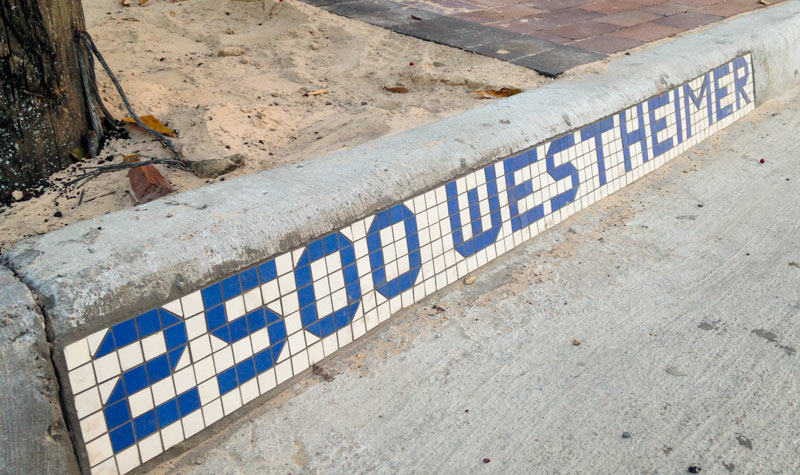 Got questions about early Texas drinking culture? Looking for info on Houston’s most prominent Bulgarian philosophers? Need to know who took the photos sketched in around that famous map of 1869 Downtown? All this and more is now archived for your online perusal in the Houston History Alliance’s new Handbook of Houston, which went live yesterday. The HHA (which the handbook says was established after then-mayor Bill White started looking for ways to make Houstonians care about the city’s history) says it had been tossing around the encyclopedia idea since 2008, but finally got a grant from the Houston Endowment to work on it with the state’s historical alliance in 2015. The initial launch includes about 1,300 articles; you can browse them all here, or help write more of them yourself. [Houston Historical Association via Houston Chronicle; previously on Swamplot] Photo of new-ish street tiles styled after Houston’s historic ones: James Glassman
Got questions about early Texas drinking culture? Looking for info on Houston’s most prominent Bulgarian philosophers? Need to know who took the photos sketched in around that famous map of 1869 Downtown? All this and more is now archived for your online perusal in the Houston History Alliance’s new Handbook of Houston, which went live yesterday. The HHA (which the handbook says was established after then-mayor Bill White started looking for ways to make Houstonians care about the city’s history) says it had been tossing around the encyclopedia idea since 2008, but finally got a grant from the Houston Endowment to work on it with the state’s historical alliance in 2015. The initial launch includes about 1,300 articles; you can browse them all here, or help write more of them yourself. [Houston Historical Association via Houston Chronicle; previously on Swamplot] Photo of new-ish street tiles styled after Houston’s historic ones: James Glassman
Tag: Books
TALK ASTRODOME TOMORROW WITH THE GUYS THAT WROTE THE BOOK ON IT 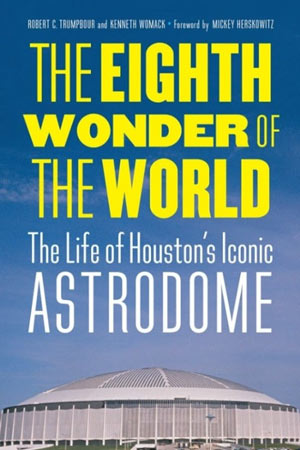 There’s a new tell-all biography of the Astrodome out this fall, now that year 50 since the stadium’s mid-1965 opening has wrapped up. Robert C. Trumpbour and Kenneth Womack’s The Eighth Wonder of the World: The Life of Houston’s Iconic Astrodome covers Dome history from its development days, and gets into how the building shaped Houston and Houston’s reputation. The authors, one of whom has also written another book about stadium construction politics, will be in town tomorrow night for a free talk and book signing — you can check out the when-and-where and RSVP here. The book includes what University of Nebraska Press refers to as some of the structure’s more “memorable problems, such as outfielders’ inability to see fly balls and failed attempts to grow natural grass — which ultimately led to the development of Astroturf.” The text also touches on some of the most recent will-they-won’t-they preservation scuffles— though its publication date precedes this year’s approval by Harris County of initial funding for that plan to turn the bottom levels of the stadium into a parking garage.  [University of Nebraska Press] Image of book cover: University of Nebraska Press
There’s a new tell-all biography of the Astrodome out this fall, now that year 50 since the stadium’s mid-1965 opening has wrapped up. Robert C. Trumpbour and Kenneth Womack’s The Eighth Wonder of the World: The Life of Houston’s Iconic Astrodome covers Dome history from its development days, and gets into how the building shaped Houston and Houston’s reputation. The authors, one of whom has also written another book about stadium construction politics, will be in town tomorrow night for a free talk and book signing — you can check out the when-and-where and RSVP here. The book includes what University of Nebraska Press refers to as some of the structure’s more “memorable problems, such as outfielders’ inability to see fly balls and failed attempts to grow natural grass — which ultimately led to the development of Astroturf.” The text also touches on some of the most recent will-they-won’t-they preservation scuffles— though its publication date precedes this year’s approval by Harris County of initial funding for that plan to turn the bottom levels of the stadium into a parking garage.  [University of Nebraska Press] Image of book cover: University of Nebraska Press
NOVEL APPROACHES TO HOUSTON 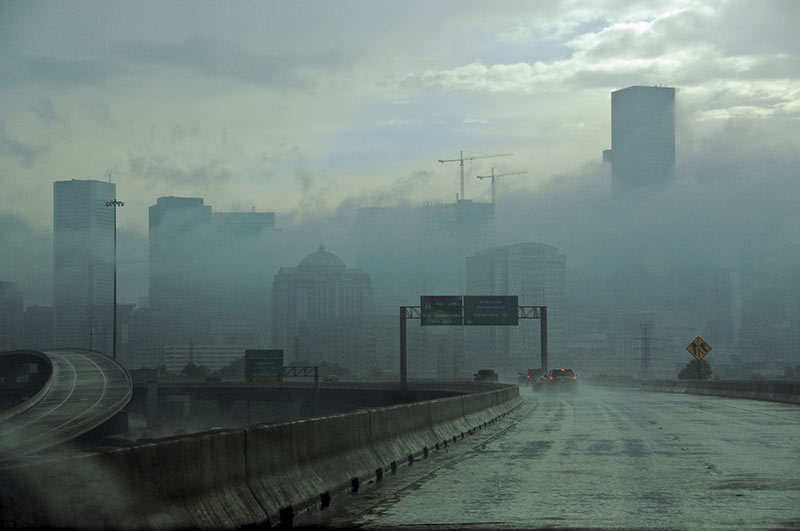 Noting the “daily clash” of old and new, local and immigrant, and very rich and very poor around these parts, “the tawdriness of those who control the city’s worst quarters,” and the density of terrific raw material for stories, Mimi Swartz wonders — as she considers 3 new novels set in the Bayou City — why Houston hasn’t served as the setting of more great fiction: “Anyone from Charles Dickens to Edith Wharton to Tom Wolfe would have or should have killed for the chance to take Houston on. And yet, so far, few have stepped up. The hands-down best novelist on Houston is Larry McMurtry; the best of his books set here — Moving On, All My Friends Are Going to Be Strangers, Terms of Endearment, and The Evening Star — evoke the place with affection and authority. But McMurtry’s last Houston book came out in 1992.” Worth mentioning since then: short stories by Antonya Nelson; a few scenes in Justin Cronin’s vampire trilogy, The Passage; Alicia Erian’s novel Towelhead; and thrillers by Attica Locke. Still, she notes, “with Houston, every writer is pretty much starting from scratch.” [Texas Monthly] Photo: faungg [license]
Noting the “daily clash” of old and new, local and immigrant, and very rich and very poor around these parts, “the tawdriness of those who control the city’s worst quarters,” and the density of terrific raw material for stories, Mimi Swartz wonders — as she considers 3 new novels set in the Bayou City — why Houston hasn’t served as the setting of more great fiction: “Anyone from Charles Dickens to Edith Wharton to Tom Wolfe would have or should have killed for the chance to take Houston on. And yet, so far, few have stepped up. The hands-down best novelist on Houston is Larry McMurtry; the best of his books set here — Moving On, All My Friends Are Going to Be Strangers, Terms of Endearment, and The Evening Star — evoke the place with affection and authority. But McMurtry’s last Houston book came out in 1992.” Worth mentioning since then: short stories by Antonya Nelson; a few scenes in Justin Cronin’s vampire trilogy, The Passage; Alicia Erian’s novel Towelhead; and thrillers by Attica Locke. Still, she notes, “with Houston, every writer is pretty much starting from scratch.” [Texas Monthly] Photo: faungg [license]
WHAT THE HISTORIC FREEDMEN’S TOWN ACROSS THE TRACKS FROM THE WOODLANDS LOOKS LIKE TODAY 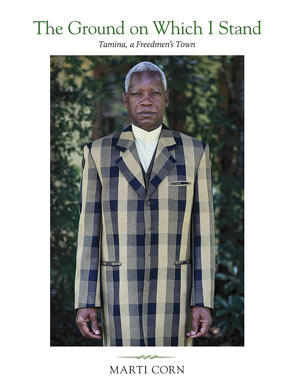 Houston-based photographer Marti Corn’s newly-published book The Ground on Which I Stand documents the history and visuals of Tamina, an unincorporated community still occupied by the descendants of freed slaves who settled in the area immediately east of I-45 and the Missouri Pacific railroad from what’s now the Woodlands back in 1871. Corn tells Mark Murrmann that Tamina’s 1960s-and-70s enclosure by affluent suburbs, and the community’s complex relationship with those developments, is part of what drew her to photograph the area. The book of portraits includes stories compiled from 15 families (both relatives of original founders and late-comers to the area); collected family photos supplement Corn’s original snapshots. [Texas A&M University Press; previously on Swamplot]
Houston-based photographer Marti Corn’s newly-published book The Ground on Which I Stand documents the history and visuals of Tamina, an unincorporated community still occupied by the descendants of freed slaves who settled in the area immediately east of I-45 and the Missouri Pacific railroad from what’s now the Woodlands back in 1871. Corn tells Mark Murrmann that Tamina’s 1960s-and-70s enclosure by affluent suburbs, and the community’s complex relationship with those developments, is part of what drew her to photograph the area. The book of portraits includes stories compiled from 15 families (both relatives of original founders and late-comers to the area); collected family photos supplement Corn’s original snapshots. [Texas A&M University Press; previously on Swamplot]
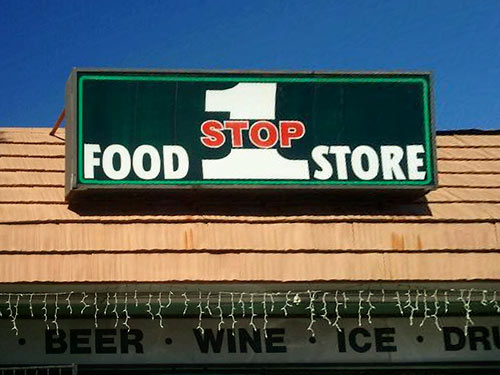
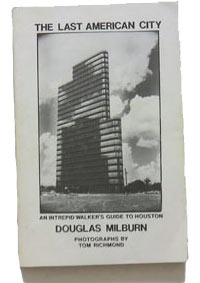
In the tragically out-of-print The Last American City: An Intrepid Walker’s Guide to Houston, magazine writer and editor and Rice German professor Douglas Milburn took a break from his bipedal tours of Montrose, the Galleria, downtown and the Med Center to share his hard-won, footsore knowledge of Houston’s finest convenience stores, circa 1979.
It was a propitious moment for the convenience store concept; gas stations had yet to erode their share of the quick and easy food and drinks market, so Milburn had plenty to choose from, not least, from among dozens of U-Tote’Ms.
Guided by Leroy Melcher, U-Tote’M was arguably Houston’s most beloved homegrown convenience store chain, albeit one bearing a name and totem pole imagery that would be considered wildly offensive by today’s standards.
A Tulsa U-Tote-M made a cameo in The Outsiders:
MAKING THE CASE FOR HOUSTON MURDERS 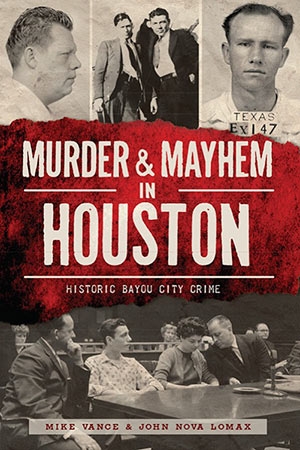 “Houston and New Orleans stand alone as the creepiest cities on the Gulf Coast,” declare Mike Vance and John Nova Lomax. “With its pervasive voodoo ambience, sprawling cities of the dead, air of genteel decay and long history of murder and mayhem, New Orleans is undeniably a spooky town. Fright is a cottage industry there. Having said that, Houston is not far behind. Houstonians just don’t celebrate death and the past the way New Orleanians do.” Their new book, Murder & Mayhem in Houston: Historic Bayou City Crime, attempts to resurrect lesser-known crime stories that have “slipped into the recesses of this city’s gargantuan memory hole,“ with chapters on the Todville Mansion murder, the Heights House of Horrors, and the Wig Shop Murder. “Local histories have tended to gloss over this city’s dark side,” they write in the book’s preface, “choosing instead to cite the ever-increasing tonnage coming and going from the Houston Ship Channel, the scientific wonders of NASA and the Texas Medical Center, the ï¬nancial feats of powerful banker-developers like Jesse Jones and the gargantuan deeds of the great oil men. That’s important history to record, but that’s only half of Houston’s story. It’s high time the dark side comes to light.” [The History Press; Amazon]
“Houston and New Orleans stand alone as the creepiest cities on the Gulf Coast,” declare Mike Vance and John Nova Lomax. “With its pervasive voodoo ambience, sprawling cities of the dead, air of genteel decay and long history of murder and mayhem, New Orleans is undeniably a spooky town. Fright is a cottage industry there. Having said that, Houston is not far behind. Houstonians just don’t celebrate death and the past the way New Orleanians do.” Their new book, Murder & Mayhem in Houston: Historic Bayou City Crime, attempts to resurrect lesser-known crime stories that have “slipped into the recesses of this city’s gargantuan memory hole,“ with chapters on the Todville Mansion murder, the Heights House of Horrors, and the Wig Shop Murder. “Local histories have tended to gloss over this city’s dark side,” they write in the book’s preface, “choosing instead to cite the ever-increasing tonnage coming and going from the Houston Ship Channel, the scientific wonders of NASA and the Texas Medical Center, the ï¬nancial feats of powerful banker-developers like Jesse Jones and the gargantuan deeds of the great oil men. That’s important history to record, but that’s only half of Houston’s story. It’s high time the dark side comes to light.” [The History Press; Amazon]
RIVER OAKS AND HIGHLAND PARK: SEPARATED AT BIRTH? 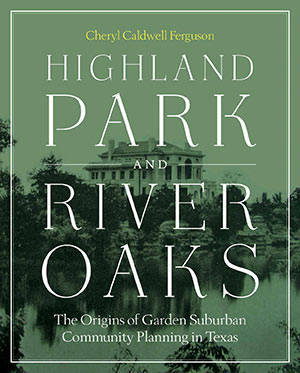 They each contain some of their city’s most expensive homes, and gave their name to classic (well, in one instance used-to-be-classic) 1930s shopping centers. But just how comparable are Dallas’s Highland Park and Houston’s River Oaks? Cheryl Caldwell Ferguson’s new book — bearing the complicated title Highland Park and River Oaks — delves into the history of the 2 garden-style suburbs and their associated retail ventures, as well as their connections to larger city-planning efforts that flopped. [UT Press; Amazon]
They each contain some of their city’s most expensive homes, and gave their name to classic (well, in one instance used-to-be-classic) 1930s shopping centers. But just how comparable are Dallas’s Highland Park and Houston’s River Oaks? Cheryl Caldwell Ferguson’s new book — bearing the complicated title Highland Park and River Oaks — delves into the history of the 2 garden-style suburbs and their associated retail ventures, as well as their connections to larger city-planning efforts that flopped. [UT Press; Amazon]
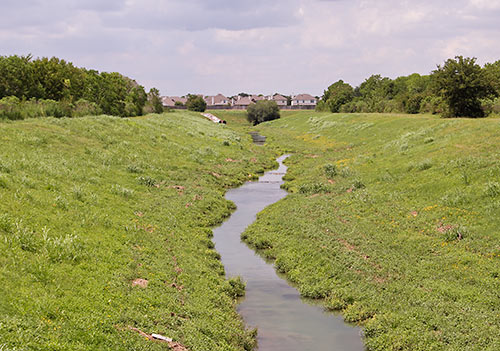
Inspired by reading René Steinke’s new and recently optioned-for-film novel Friendswood, the plot of which centers on the aftermath of the Brio Superfund mess just south of I-45 and the Beltway, Cite magazine’s Allyn West returns to the former chemical waste facility at Dixie Farm Rd. and Beamer Rd. to snap some photos and have a look around: “The first thing you pass is a landfill. And then, incongruously, you pass archetypal subdivisions with bucolic names, much like Southbend must have been. There’s a dedicated bike lane on both sides of Dixie Farm, clearly marked and freshly painted. Then turning toward the site onto Blackhawk Boulevard, you pass Ashley Pointe, a new subdivision. That morning, I saw construction workers milling about around unfinished stick frames. If Southbend still existed, Ashley Pointe would sit right next to it.”
BUILDING THE BIGGEST LIVING ROOM IN THE WORLD 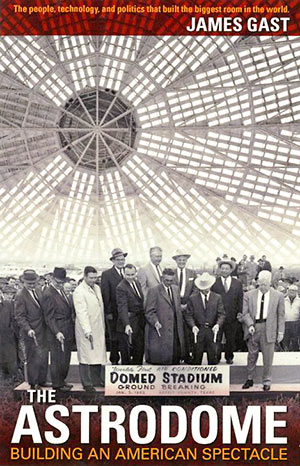 From the prologue to The Astrodome: Building a Domed Spectacle, James Gast’s just-published history of the origins of the Harris County Domed Stadium: “The Astrodome is not a distinctive work of architecture. It is certainly not a bad building, nor is it an exceptionally beautiful one. The Astrodome ended its days as a major league venue in 1999, but it remains a uniquely influential building. On the simplest level, it changed the game of baseball and — in the opinion of legions of self-described purists — not for the better. If you happen to be a student of the game, you know that the artificial turf first introduced at the Astrodome changed the way baseball was played, placing a new emphasis on speed and spawning a generation of light-hitting speedsters playing on artificial turf fields with deep fences.
Off the field, the Astrodome’s creature comforts and barrage of electronic media forever changed the way the game is viewed. The Dome rose alongside the growing influence of television, and stood as a response to a commercial threat posed by television. To lure paying customers away from their TV sets and into the ballpark, stadiums needed to deliver comfort and amenities on par with the spectators’ living rooms. The Dome competed with television by emulating it: a comfortable seat, good food, and frequent electronic distractions. If, while at Phoenix’s Chase field, you find yourself engrossed in a video on the 6,200-square—foot high-definition scoreboard while enjoying curried chicken tacos with mint-marinated cucumbers and yogurt on top of scallion pancakes, you can thank — or curse — the Astrodome.” [Astrodome Book]
From the prologue to The Astrodome: Building a Domed Spectacle, James Gast’s just-published history of the origins of the Harris County Domed Stadium: “The Astrodome is not a distinctive work of architecture. It is certainly not a bad building, nor is it an exceptionally beautiful one. The Astrodome ended its days as a major league venue in 1999, but it remains a uniquely influential building. On the simplest level, it changed the game of baseball and — in the opinion of legions of self-described purists — not for the better. If you happen to be a student of the game, you know that the artificial turf first introduced at the Astrodome changed the way baseball was played, placing a new emphasis on speed and spawning a generation of light-hitting speedsters playing on artificial turf fields with deep fences.
Off the field, the Astrodome’s creature comforts and barrage of electronic media forever changed the way the game is viewed. The Dome rose alongside the growing influence of television, and stood as a response to a commercial threat posed by television. To lure paying customers away from their TV sets and into the ballpark, stadiums needed to deliver comfort and amenities on par with the spectators’ living rooms. The Dome competed with television by emulating it: a comfortable seat, good food, and frequent electronic distractions. If, while at Phoenix’s Chase field, you find yourself engrossed in a video on the 6,200-square—foot high-definition scoreboard while enjoying curried chicken tacos with mint-marinated cucumbers and yogurt on top of scallion pancakes, you can thank — or curse — the Astrodome.” [Astrodome Book]
HOW THE BEER CAN HOUSE GOT ITS BEER, AND OTHER ESSENTIAL STORIES OF ENSHRINED HOUSTON WACKINESS 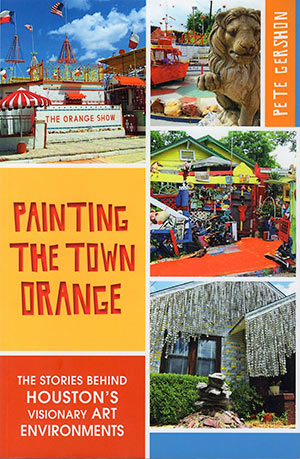 Somebody oughta write a history, you’ve probably thought at some point, of the singular, weird art treasures like the Orange Show, the Beer Can House, the Flower Man‘s house, and okay, maybe Pigdom and TemplO and Notsuoh — that give Houston legitimate license to call itself funky. But it took a relative newcomer — writer Pete Gershon moved to Houston in 2005 — to conduct all the interviews and get these and other stories down on paper. Gershon’s new book, Painting the Town Orange: The Stories Behind Houston’s Visionary Art Environments, weaves together tales of the creation and preservation of these and other unique urban places, giving a detailed view of the thinking (and in at least one instance, drinking) that put them together and drew others to them. Sections on Grace Bashara Green’s stuffed-to-the-gills house at 414 Avondale St., David David Smalley’s Miniature Museum at 1406 Welch, Dolan Smith’s Museum of the Weird, and Bill Davenport’s 11th St. junk shop art studio on 11th St. were cut from the manuscript before it was published, but posted separately on the art blog The Great God Pan Is Dead. [Brazos Bookstore]
Somebody oughta write a history, you’ve probably thought at some point, of the singular, weird art treasures like the Orange Show, the Beer Can House, the Flower Man‘s house, and okay, maybe Pigdom and TemplO and Notsuoh — that give Houston legitimate license to call itself funky. But it took a relative newcomer — writer Pete Gershon moved to Houston in 2005 — to conduct all the interviews and get these and other stories down on paper. Gershon’s new book, Painting the Town Orange: The Stories Behind Houston’s Visionary Art Environments, weaves together tales of the creation and preservation of these and other unique urban places, giving a detailed view of the thinking (and in at least one instance, drinking) that put them together and drew others to them. Sections on Grace Bashara Green’s stuffed-to-the-gills house at 414 Avondale St., David David Smalley’s Miniature Museum at 1406 Welch, Dolan Smith’s Museum of the Weird, and Bill Davenport’s 11th St. junk shop art studio on 11th St. were cut from the manuscript before it was published, but posted separately on the art blog The Great God Pan Is Dead. [Brazos Bookstore]
A ‘FIELD GUIDE’ TO HOUSTON FOOD TRUCKS 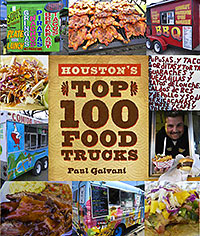 A new book declares which among the estimated 1,400 are the best food trucks in Houston: Houston Chronicle food writer and UH marketing professor Paul Galvani tells a 392-page story of what he calls “the food truck movement,” providing maps and reviews of his 100 favorites, like Good Dog Hot Dog and The Modular, which gave rise to the recently opened Downtown ramen shop Goro & Gun. Houstonia food writer and El Real Tex Mex co-founder Robb Walsh doesn’t seem to think this is a book meant for the coffee table, blurbing, “I plan to carry a copy in my car as a field guide . . . .” [Houston’s Top 100 Food Trucks; previously on Swamplot] Photo: Houston’s Top 100 Food Trucks via Swamplot inbox
A new book declares which among the estimated 1,400 are the best food trucks in Houston: Houston Chronicle food writer and UH marketing professor Paul Galvani tells a 392-page story of what he calls “the food truck movement,” providing maps and reviews of his 100 favorites, like Good Dog Hot Dog and The Modular, which gave rise to the recently opened Downtown ramen shop Goro & Gun. Houstonia food writer and El Real Tex Mex co-founder Robb Walsh doesn’t seem to think this is a book meant for the coffee table, blurbing, “I plan to carry a copy in my car as a field guide . . . .” [Houston’s Top 100 Food Trucks; previously on Swamplot] Photo: Houston’s Top 100 Food Trucks via Swamplot inbox
AN UPDATED GUIDEBOOK TO HOUSTON BUILDINGS NEW AND THROUGH  The third edition of the Houston Architectural Guide won’t be available officially until October 8th, but the Houston AIA is now taking pre-orders through September at a discounted price (PDF). The latest version of the encyclopedic catalog and tour guide, updated by Stephen Fox, will include 340 new entries covering structures that have popped up in the last 13 years — plus a whole bunch more from the last edition, moved to the back-of-the-book “now demolished” section. [AIA Houston]
The third edition of the Houston Architectural Guide won’t be available officially until October 8th, but the Houston AIA is now taking pre-orders through September at a discounted price (PDF). The latest version of the encyclopedic catalog and tour guide, updated by Stephen Fox, will include 340 new entries covering structures that have popped up in the last 13 years — plus a whole bunch more from the last edition, moved to the back-of-the-book “now demolished” section. [AIA Houston]
IS RICE WORTH IT? 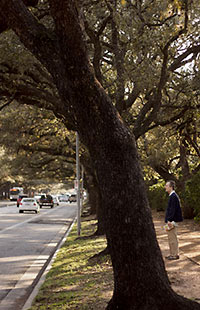 Having stood up for Houston’s heat, humidity, flying cockroaches, mosquitoes, sprawl, flooding, “no mountains,” and other typically unheralded features of the local landscape (even as more official civic campaigns shied away from the task) the folks behind the cité vérité Houston. It’s Worth It. promotional campaign are ready to move onto their next crowdsourced publishing project. “Contrary to the way it might sound,” declares a splash page announcing the project, HIWI: Rice “is not a cookbook. Nor, for all you anxious undergrads, is it a text book.” Instead, the publishers at communications firm ttweak are hoping to produce a collection of comments, stories, and photos that’ll end up serving as “part love letter, part roast, part remembrance” of Rice University, on the occasion of the institution’s 100th birthday. Working from the same model that produced the original Houston. It’s Worth It. book and HIWI: Ike, the publishers are soliciting contributions from anyone who has anything to say about the campus, its people, and its place in the city: “Have you ever shot bottle rockets in the parking lot? Were you there for Kennedy’s speech? Ever knocked back a few at Valhalla? . . . Even if you’ve never set foot inside a Rice classroom, we want to know what the ‘Institute’ means to you.” [HIWI; previously on Swamplot] Photo: ttweak
Having stood up for Houston’s heat, humidity, flying cockroaches, mosquitoes, sprawl, flooding, “no mountains,” and other typically unheralded features of the local landscape (even as more official civic campaigns shied away from the task) the folks behind the cité vérité Houston. It’s Worth It. promotional campaign are ready to move onto their next crowdsourced publishing project. “Contrary to the way it might sound,” declares a splash page announcing the project, HIWI: Rice “is not a cookbook. Nor, for all you anxious undergrads, is it a text book.” Instead, the publishers at communications firm ttweak are hoping to produce a collection of comments, stories, and photos that’ll end up serving as “part love letter, part roast, part remembrance” of Rice University, on the occasion of the institution’s 100th birthday. Working from the same model that produced the original Houston. It’s Worth It. book and HIWI: Ike, the publishers are soliciting contributions from anyone who has anything to say about the campus, its people, and its place in the city: “Have you ever shot bottle rockets in the parking lot? Were you there for Kennedy’s speech? Ever knocked back a few at Valhalla? . . . Even if you’ve never set foot inside a Rice classroom, we want to know what the ‘Institute’ means to you.” [HIWI; previously on Swamplot] Photo: ttweak
LOCAL WEBSITE MAKES BOOK 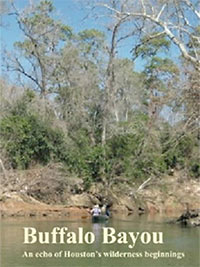 Does li’l ol’ Buffalo Bayou qualify for a river guide? It does now. Longtime bayou history boat tour guide Louis Aulbach — author of 5 river guides chronicling the courses and histories of a few West Texas waterways — has just published Buffalo Bayou: An Echo of Houston’s Wilderness Beginnings as a book. If you’re a bayou or local history buff and that title sounds familiar, it should: Aulbach has been posting extended excerpts from the project on his old-school HAL-PC website for years. [Memorial Examiner; Amazon link]
Does li’l ol’ Buffalo Bayou qualify for a river guide? It does now. Longtime bayou history boat tour guide Louis Aulbach — author of 5 river guides chronicling the courses and histories of a few West Texas waterways — has just published Buffalo Bayou: An Echo of Houston’s Wilderness Beginnings as a book. If you’re a bayou or local history buff and that title sounds familiar, it should: Aulbach has been posting extended excerpts from the project on his old-school HAL-PC website for years. [Memorial Examiner; Amazon link]
EVERYTHING YOU EVER WANTED TO KNOW ABOUT HOUSTON FREEWAYS — FOR FREE 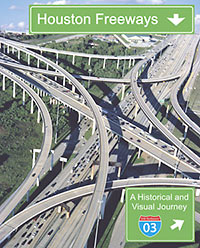 A reader writes in to make sure we were aware that the world’s best book on the popular topic of Houston-area freeways — which just happens to be entitled Houston Freeways — is available as a free PDF ebook download on the author’s website (yes, HoustonFreeways.com). Sharpstown native Erik Slotboom’s freeway-photo-filled 416-page opus has been out of print since 2005, though dedicated freeway fans can still scrounge up an only mildly battered physical copy for upwards of $100 on Amazon and other sites. Online only: Slotboom’s 5-year photo update of all the Houston Freeway happenings that took place between 2003 and 2008.
A reader writes in to make sure we were aware that the world’s best book on the popular topic of Houston-area freeways — which just happens to be entitled Houston Freeways — is available as a free PDF ebook download on the author’s website (yes, HoustonFreeways.com). Sharpstown native Erik Slotboom’s freeway-photo-filled 416-page opus has been out of print since 2005, though dedicated freeway fans can still scrounge up an only mildly battered physical copy for upwards of $100 on Amazon and other sites. Online only: Slotboom’s 5-year photo update of all the Houston Freeway happenings that took place between 2003 and 2008.

